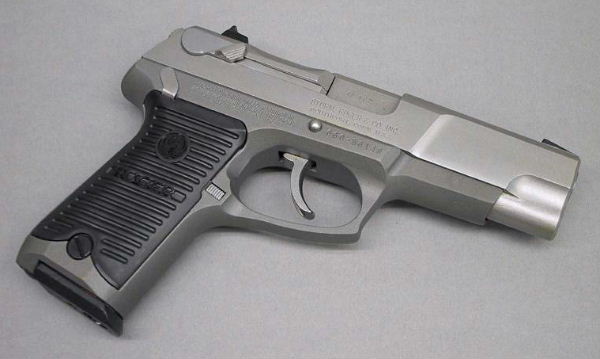|
Ruger
|
RUGER 10MM FIREARMS |
| Model |
Description |
Status |
Rating |
| Blackhawk "Buckeye" .38-40/10mm Converible |
Single action revolver with 6-1/2" barrel. Comes with
two cylinders; one in .30-40 Winchester, and another in 10mm Auto. |
Discontinued |
 |
|
Additional Notes: The Ruger Blackhawk "Buckeye" Convertible
is, like all Ruger revolvers, a strong and reliable firearm. It comes with two interchangeable cylinders allowing the shooter
to switch from .38-40 Winchester to 10mm Auto in a matter of seconds. |
OVERVIEW
Unlike most other manufacturers, Ruger's 10mm is not a semiautomatic pistol. The Ruger Blackhawk "Buckeye" Convertible
is a single-action revolver. Like all Ruger Blackhawks, this 10mm Auto version is strong and ultra-reliable. As this particular
Blackhawk is a "Convertible" model it comes with a second cylinder in a different caliber. Both the 10mm Auto and
the .38-40 Winchester use .400" caliber projectiles and so either caliber can be fired down the Blackhawk's barrel by
simply switching cylinders.
DETAILS / OBSERVATIONS / SHOOTING CHARACTERISTICS
Details
As already mentioned, Ruger's 10mm came in the form of it's popular single-action Blackhawk revolver. This was a run of 5,000
guns for Buckeye Sports Supply, and truth be told it wasn't actually a dedicated 10mm, but rather a dual-cylinder convertible
with one cylinder in 10mm Auto and the other in .38-40 Winchester.
Ruger Blackhawk "Buckeye" Convertible - The Buckeye .38-40/10mm revolver is basically a
standard Blackhawk with blued finish, wood grips, and a 6-1/2" barrel. Besides the dual-cylinders the only other distinguishing
feature is a Buckeye roll-stamp on the top of the frame. The long sight radius and adjustable sights contribute to accuracy,
but the Buckeye, like all Ruger Blackhawks, does not have a very user-friendly trigger.
The Ruger Buckeye is not the only revolver chambered for the 10mm Auto though. Probably the best known 10mm revolver is the
Smith & Wesson 610 built on the company's large, double-action N-frame. There are, however, two important differences between
the Buckeye and the 610. As the 610 uses a swing-out cylinder and a star extractor, moon clips are required for ejecting
the cases (fired or unfired). The Ruger, on the other hand, ejects it's empties one at a time through the loading gate via
a pushrod housed under the barrel. There are advantages and disadvantages to both systems. The Smith & Wesson requires the
moon clips for proper ejection of the cases, while the Ruger doesn't need them. On the other hand, because of the moon clips
the cartridge headspaces on the clip and not on the case mouth, and this is what allows the S&W to also safely chamber and
fire the shorter .40 S&W cartridge. To do this in the Ruger you would need a different cylinder (not cheap!).
Observations
If you have any experience with Ruger's Blackhawk single-action revolvers there isn't much new about the Buckeye Convertible.
The only notable difference, aside from caliber, is the Buckeye flower rollstamp on the topstrap. The nice thing about the
Ruger though, is that they are built like tanks! If you also take into consideration the long cylinder of the revolver (no
need for an max OAL of 1.260" in the Blackhawk!), then the potential for some rather "spicy" handloads is hard to ignore!
I have heard of a number of people who have had their S&W 610 reamed out to 10mm Magnum dimensions. I have never heard of
anyone doing this with the Blackhawk Buckeye, but by having a second cylinder made in 10mm Magnum you could fire an even more
powerful cartridge without altering the original (and collectible) gun.
Shooting Characteristics
Shooting the 10mm Blackhawk is not exactly a unique experience, but it is fun! Recoil, compared to my 4-5/8" .357 Magnum
Blackhawk, seemed softer, but this could be due to the extra weight of the longer barrel. The longer sight radius was a definate
advantage when shooting at extended ranges and I found I had little trouble hitting the 12"x12" steel plates out at 100 yards.
When shooting the Blackhawk Buckeye 10mm you have to wonder, "What is the purpose of this gun?" The whole reason for the
10mm Auto cartridge was to put revolver power (read magnum) in a standard format semiauto pistol. Why then put this cartridge
in a gun that can already handle magnum calibers? I guess my answer would be, "Why not?" While the Blackhawk wouldn't be
my first choice for personal protection, it does make a great platform for hunting small to medium-sized game. I wouldn't
hesitate to use the 6-1/2" Buckeye on the Blacktails and coyotes that roam the woods around here.
LITERATURE
December 1990 Shooting Times
Lane Pearce writes this interesting article on the Ruger "Buckeye" Blackhawk Convertible in .38-40 Winchester and 10mm Auto.
The piece not only covers the technical aspects of the revolver, but also how it came into being.
ADDITIONAL INFORMATION
The Original Ruger 10mm?
There have been rumors floating about for years that Ruger had originally planned another 10mm handgun. This gun is the Ruger
P90 semiauto pistol, and the rumor is that this gun was initially designed with the 10mm cartridge in mind when it became
known that the F.B.I. was looking to make the 10mm Auto its standard issue caliber. Apparently Ruger decided to halt development
of the 10mm chambering, for whatever reason, and instead built the P90 as a .45 ACP. This is unfortunate, as Ruger's well
deserved reputation for building "tough" guns would have undoubtedly resulted in one of the best 10mm guns built. I guess
we'll never know...

|
| Ruger P90 in .45 ACP. |

|

